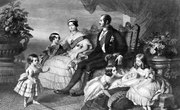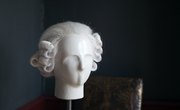Nineteenth century social etiquette required girls to uphold a rigorous standard of beauty, poise and excellence, particularly for those from wealthy and prestigious families. Years of training, refining and practice helped well-to-do girls learn proper behavior applicable to various social situations. Social expectations in the 1800s led many upper class girls to strive for absolute perfection in their style of dress, social network and educational options. Working class girls of this era generally did not have the financial resources or time to dedicate to learning such standards.
Exchanging Pleasantries
Girls in the 19th century were taught to display utmost respect for others during conversation. Although girls learned to appear as agreeable and as pleasant as possible, they were careful to avoid discussing personal family matters or other potentially embarrassing private issues. Proper social etiquette required young girls to refrain from raising their voices or using crude language. Girls knew to be on their best behavior when speaking with a man.
Visiting Protocol
Beginning in Europe early in the 1800s and spreading to America in the middle of the century, calling cards were used as a way for upper and middle class girls to demonstrate social status. Young ladies would receive calls from visitors based on the time and day engraved on a piece of fine white paper. If a boy or girl wished to call upon a girl for any social purpose, he or she would present a calling card to the girl’s servant to deliver to the intended. If the young girl decided she was interested in meeting with the caller, she would return her card to the caller. Once this complicated exchange had taken place, formal plans were made for the caller and young girl to meet.
Style and Attire
Social etiquette dictated very specific wardrobe choices for 19th century girls, particularly for those from well-to-do families. According to the Memorial Hall Museum, girls in the early 1800s wore drawers, a chemise and stockings under their other clothing, similar to modern day underwear, socks or tights and slips. Corsets were worn to improve posture and girls’ overall shape. Beginning around age 12, girls wore their hair in high buns on their head, often held in with decorative clips and then covered with a white cap. While the Grand Rapids Historical Commission reports style etiquette for young girls evolved throughout the 1800s to reflect current social and fashion trends, specific requirements for modest skirt lengths and socially acceptable neck lines remained in place throughout the century.
Finishing Schools
According to a 2009 ''Vanity Fair'' article, the 19th century generally had few educational options for girls. Finishing schools offered not only academic opportunities, but they also gave girls training in social graces and proper etiquette. Although some academics were taught, the primary goal of such schools was to help girls learn to be good wives and more interesting women overall. Girls would learn socially acceptable behavior such as listening while others are speaking and contributing intelligently, yet demurely.
Related Articles
References
Resources
Writer Bio
Amy Pearson earned dual bachelor's degrees in management and horticulture. She is a licensed elementary teacher for kindergarten through sixth grades. Pearson specializes in flower and vegetable gardening, landscape design, education, early childhood and child development.











